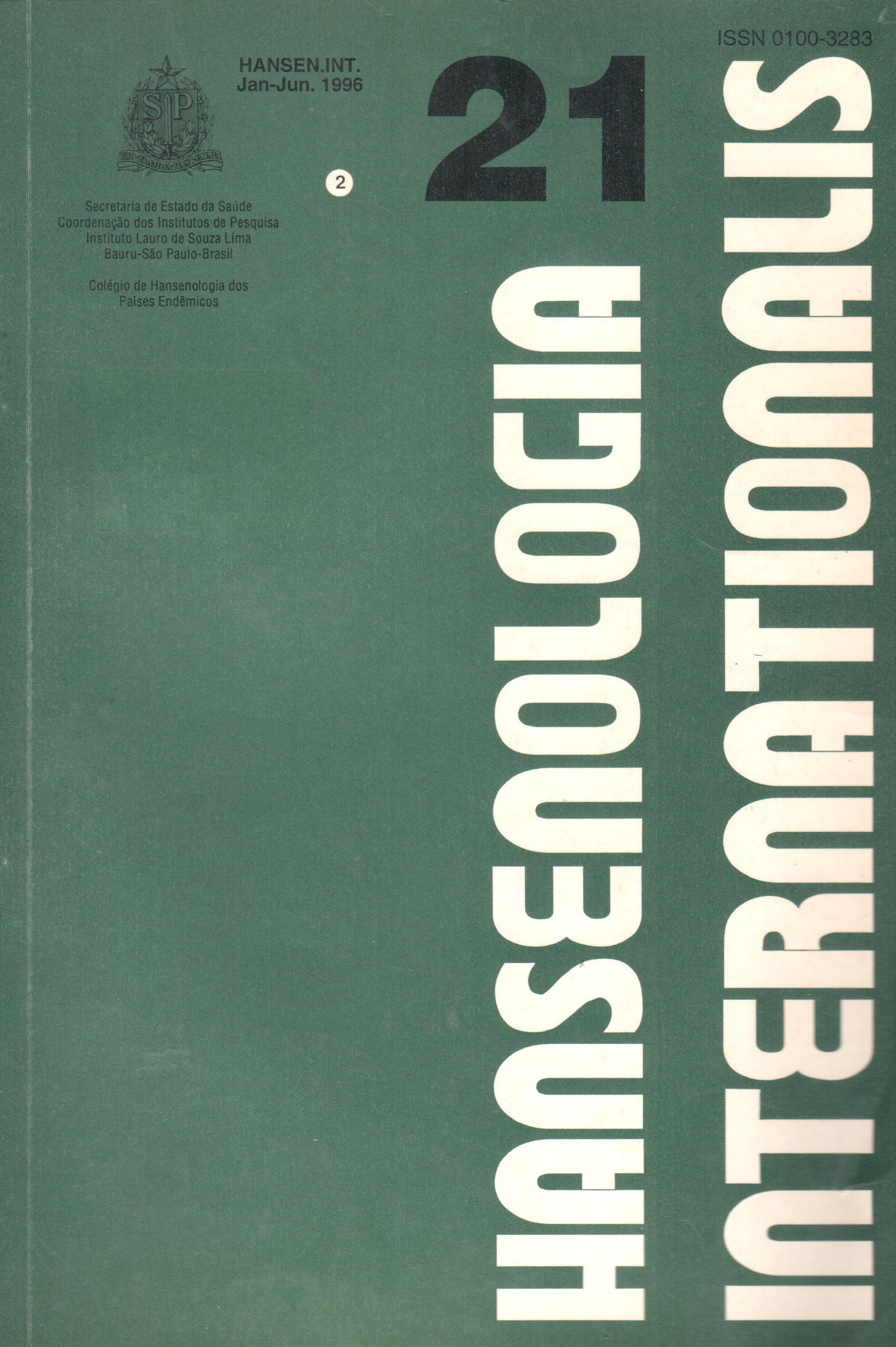Granulomatose dewegener e hanseníase: apenas uma associação fortuita?
DOI:
https://doi.org/10.47878/hi.1996.v21.36477Keywords:
Wegener's granulomatosis, complication, leprosyAbstract
The authors review a case of a male patient presenting borderline lepromatous leprosy for 28 years. After release from treatment ( with negative skin-smears) he was under irregular dapsone monotherapy. Ten years later he showed again active skin lesions with positive skin smears (2+ with some solid stained bacilly ). Suspecting of dapsone resistance, he was put under Clofazimine for 12 months showing partial regression of the skin lesions. Although he continued to use dapsone after this period, the skin lesions contined to show regression and skin smears presented no solid stained bacilli. Episodes of ENL were note in this period. Four years before death, he began to present signs of Chronic Renal Failure which was
related to a probable secondary amyloidosis due to leprosy. Autopsy revealed (1) intense impregnation of CFZin the mucosa of the upper air up-pathway stomach and bowels, as well as in limphnodes; (2) regressive lepromatous infiltrate with positive baciloscopy with granular bacilli in various sites and some organs sucha as liver, spleen and limphnodes; (3) amyloid deposits in several organs and (4) a necrotizing nodular lesion close to the principal bronchi of the right lung, showing palisaded granuloma and granulomatous vasculitis, which was interpreted as a localized pulmonary maniíestation of Wegener's Granulomatosis (WG). The evidences showed that it was indeed a case of advanced borderline leprosy associated, fortuitously or not, to a WG, in the initial phase or an asymptomatic limited form. There is no mention of such association in the literature. It is assumed that the WG could be related to some unidentified bacteria which exposes neutrophilic proteasis producing antibodies to neutrophil cytoplasmic antigens (ANCAs). The authors suggest the possibility of leprosy, to be the underlying bacterial disease in this case. The
determination of these antibodies in leprosy and the search for WG may suggest a real association between these two intriguing clinical entities.
Downloads
References
2 . ANDRASSY, K. Rapidl y progres s ive glomerulonephritis and Wegener's granulomatosis. Nephrologie, 13(6) 279-81, 1992.
3. BRASIL, M.T.L.R.F.; OPROMOLLA, D.V.A. at al. Results of a surveillance system for adverse effects in leprosy's WHO/MDT. Int.J.Leprosy, 64(2):97-104,1996.
4. CHYU, J.Y.H.; HAGSTROM, W.J. et al. Wegener's granulomatosis in Childhood. J. Am. Acad. Dermatol., 10: 341-6. 1984.
5. FAUCI, A.S. et al. Wegener's granulomatosis: prospective clinical and therapeutic experience with 85 patients for 21 years. Ann. Intern. Med., 98: 76-85, 1983.
6. FLEURY, R.N.; TONELLO, C.S. et al. Hanseníase dimorfa com surtos de reação hansênica e lesões viscerais. Hansenol. Int., 4:116-25,1979.
7. FLEURY, R.N. in: Silva, I.M. Dermatologia, Rio de Janeiro-São Paulo: Atheneu, p. 89-100, 1983.
8. FRANCES, C. et al. Wegener's granulomatosis: dermatological manifestations in 75 cases with clinicopathologic correlation. Arch. Dermatol.,130(7): 861-67, 1994.
9. FURUTA, M. et al. Leprosy and malignancy: autopsy findings of 252 leprosy patients.Int. J. Dermatol., 58(4):697-703,1990
10. GUTIERRES-RAV, V.M.; AYERZA, M.A. Hilar and mediastinal lymphadenopathy in the limeted form of Wegener's granulomatosis.Thorax, 46(3):219-20,1991.
11. HAMMAR, S.P. Granulomatous vasculitis. Semin. Respir. Infect., 10 (2): 107-20,1995.
12. HOWELL, S.B.; EPSTEIN, W.V. Circulating immunoglobulin complexes in Wegener's granulomatosis. Am. J. Med, 60:259-68, 1976.
13. JENNETTE, C.J. et al. Vasculitis affecting the skin: a review. Arch.Dermatol.,130:899-906, 1994.
14. KAVANAGH, G.M. et al. Eritema elevatum diutinum associated with Wegener's granulomatosis and IgA paraproteinemia. J.Am. Acad. Dermatol.,
28 (5 pt 2): 846-9, 1993.
15. KRAFCIK, S.S. at al. Wegener's granulomatosis in the elderly. Chest, 109 (2): 430-7, 1996.
16. LEAVIT, R.Y.; FAUCI, A.S. at al. The American College of Rheumatology 1990 criteria for the classification of Wegener's granulomatosis. Arthritis Rheum., 33: 1101-7, 1990.
17. LOCKWOOD, D.N.J. The management of erythema nodosum leprosum: current and future options. Lepr. Rev., 67: 253-9, 1996.
18. MANGOLD, M.C.; CALLEN, J.P. Cutaneous leukocytoclastic vasculite associated with active Wegener's granulomatosis. J. Am. Acad. Dermatol., 26 (4): 579-84, 1992.
19. NAAFS, B.Treatment of Reactions and Nerve Damage.Int.J.Leprosy, 64(4): S21-28, 1996.
20. OPROMOLLA, D.V.A.; FLEURY, R.N.; TABORDA, P.R.O. Caso de Hansen íase virchoviana subpolar tratado com a PQT/OMS. Hansenol. Int., 21(1-2): 67-74, 1996.
21. RIDLEY, D.S.; JOPLING W.H. Classification of leprosy acording to immunity. Afive-group system. Int.J.Leprosy, 34(3):255-73,1966.
22. ROOK, A. at al. eds.Textbook of Dermatology. 5th ed. Oxford: Blackwell, 1988.
23. ROTTERN, M.; FAUCI, A.S. et al. Wegener granulomatosis in children and adolescent: clinical presentation and outcome. J. Pediatr., 122(1): 26-31,1993.
24. SARNO, E.N.; SAMPAIO, E.P. The role of inflammatory cytokines in the tissue injury of leprosy. Int. J. Leprosy, 64(4): S69-S74, 1996.
25. SOUKIASIAN, S.H. at al. Trimethoprimsulfamethoxazole for escleritis associated with limited Wegener's granulomatosis: use of histopathology and anti-neutriphil cytoplasmic antibody (ANCA) test. Cornea 12(2): 174-80, 1993.
26. VASQUEZ, F.A., VARELA, N.N. et al. Enfermidad de Hansen en el Mercosur. Acta Leprologica, 10(2): 79-84, 1996.
27. WARNDORFF, D. Clofazimine-resistant leprosy.A case report. Int. J. Leprosy, 50:139-42,1982.
29. WEGENER, F. Uber generalisierte septishe gefasserkrankungen.Verh. Dtsch. Ges. Pathol., 29:202-210, 1936.
29. WEISS, M.A.; CRISSMAN, J.D. Renal biopsy findings in Wegener's granulomatosis: segmental necrotizing glomerulonephritis with glomerular thrombosis. Human Pathol., 15:
Downloads
Published
How to Cite
Issue
Section
License

This work is licensed under a Creative Commons Attribution 4.0 International License.
This journal is licensed under a Creative Commons Attribution 4.0 International License.


























